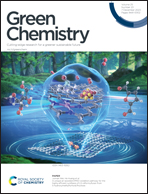The sustainability impact of Nobel Prize Chemistry: life cycle assessment of C–C cross-coupling reactions†
Abstract
Carbon-to-carbon (C–C) cross-coupling reaction (CCR) protocols represent a major breakthrough in synthetic chemistry. These innovative CCRs are widely applied in medicinal chemistry to produce a multitude of drugs, as well as in many other applied sciences. Despite strong efforts to implement green chemistry principles in synthetic chemistry, only individual outcomes for (many) single reactions with single synthesis protocols have been reported, and a comprehensive view of the environmental value of major chemical breakthroughs is lacking in the literature. This study concerns the life cycle assessment (LCA) of CCRs, which were awarded the Nobel Prize in 2010. The required materials were obtained from datasets based on industrial data, while the analysed compounds and target products from C–C coupling reaction protocols were modelled based on laboratory-scale experimental data (the only data available), and the use of electrical power was assumed. We discovered that it is essential to separate intrinsic and extrinsic impacts to allow focus on delivering a generic sustainability view. The former are the genuine generalizable innovations of the novel chemical process method, and are worth improving via LCA. The latter are outcomes of individual laboratory chemical protocols, which are aimed at achieving chemical innovation but typically not at holistically optimising the environmental profile, with a limited scope for LCA prediction. In terms of the intrinsic value of the Nobel Prize CCRs, we determined the environmental profile for variations of the (1) CCR catalyst, (2) CCR halobenzene, and (3) CCR ligand, all of which are constitutional innovations of the chemical protocols of the 2010 Nobel Prize in Chemistry. The findings indicate that (1) the catalyst should be recycled, as its footprint is far too dominating; (2) the halobenzene should be chosen carefully to balance its intrinsic (‘backpack’) and extrinsic (yield, catalyst choice) impacts; and (3) the ligand should be recycled in the context of the catalyst recycling. As demonstrated herein, the value of LCA is to provide predictions for future improvements (‘anticipatory or ex-ante LCA’) and to assure the best leverage of environmental gains that can readily be achieved for major chemical innovations, as exemplified by the 2010 Nobel Prize in Chemistry.

- This article is part of the themed collections: Measuring Green Chemistry: Methods, Models, and Metrics and Green Chemistry 25th Anniversary Collection


 Please wait while we load your content...
Please wait while we load your content...